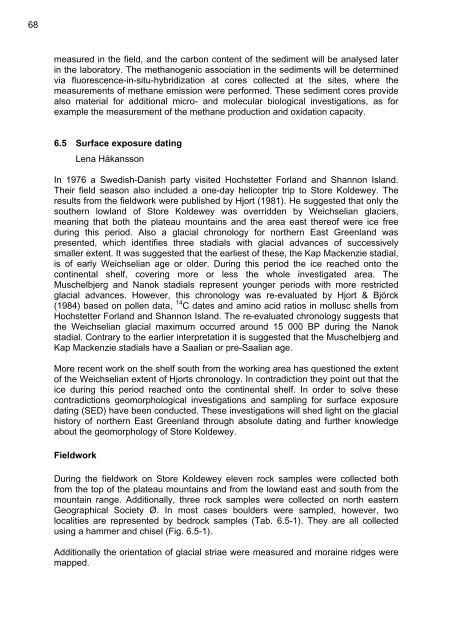the Expedition ARKTIS-XIX/4 of the research vessel POLARSTERN ...
the Expedition ARKTIS-XIX/4 of the research vessel POLARSTERN ...
the Expedition ARKTIS-XIX/4 of the research vessel POLARSTERN ...
Create successful ePaper yourself
Turn your PDF publications into a flip-book with our unique Google optimized e-Paper software.
68<br />
measured in <strong>the</strong> field, and <strong>the</strong> carbon content <strong>of</strong> <strong>the</strong> sediment will be analysed later<br />
in <strong>the</strong> laboratory. The methanogenic association in <strong>the</strong> sediments will be determined<br />
via fluorescence-in-situ-hybridization at cores collected at <strong>the</strong> sites, where <strong>the</strong><br />
measurements <strong>of</strong> methane emission were performed. These sediment cores provide<br />
also material for additional micro- and molecular biological investigations, as for<br />
example <strong>the</strong> measurement <strong>of</strong> <strong>the</strong> methane production and oxidation capacity.<br />
6.5 Surface exposure dating<br />
Lena Håkansson<br />
In 1976 a Swedish-Danish party visited Hochstetter Forland and Shannon Island.<br />
Their field season also included a one-day helicopter trip to Store Koldewey. The<br />
results from <strong>the</strong> fieldwork were published by Hjort (1981). He suggested that only <strong>the</strong><br />
sou<strong>the</strong>rn lowland <strong>of</strong> Store Koldewey was overridden by Weichselian glaciers,<br />
meaning that both <strong>the</strong> plateau mountains and <strong>the</strong> area east <strong>the</strong>re<strong>of</strong> were ice free<br />
during this period. Also a glacial chronology for nor<strong>the</strong>rn East Greenland was<br />
presented, which identifies three stadials with glacial advances <strong>of</strong> successively<br />
smaller extent. It was suggested that <strong>the</strong> earliest <strong>of</strong> <strong>the</strong>se, <strong>the</strong> Kap Mackenzie stadial,<br />
is <strong>of</strong> early Weichselian age or older. During this period <strong>the</strong> ice reached onto <strong>the</strong><br />
continental shelf, covering more or less <strong>the</strong> whole investigated area. The<br />
Muschelbjerg and Nanok stadials represent younger periods with more restricted<br />
glacial advances. However, this chronology was re-evaluated by Hjort & Björck<br />
(1984) based on pollen data, 14 C dates and amino acid ratios in mollusc shells from<br />
Hochstetter Forland and Shannon Island. The re-evaluated chronology suggests that<br />
<strong>the</strong> Weichselian glacial maximum occurred around 15 000 BP during <strong>the</strong> Nanok<br />
stadial. Contrary to <strong>the</strong> earlier interpretation it is suggested that <strong>the</strong> Muschelbjerg and<br />
Kap Mackenzie stadials have a Saalian or pre-Saalian age.<br />
More recent work on <strong>the</strong> shelf south from <strong>the</strong> working area has questioned <strong>the</strong> extent<br />
<strong>of</strong> <strong>the</strong> Weichselian extent <strong>of</strong> Hjorts chronology. In contradiction <strong>the</strong>y point out that <strong>the</strong><br />
ice during this period reached onto <strong>the</strong> continental shelf. In order to solve <strong>the</strong>se<br />
contradictions geomorphological investigations and sampling for surface exposure<br />
dating (SED) have been conducted. These investigations will shed light on <strong>the</strong> glacial<br />
history <strong>of</strong> nor<strong>the</strong>rn East Greenland through absolute dating and fur<strong>the</strong>r knowledge<br />
about <strong>the</strong> geomorphology <strong>of</strong> Store Koldewey.<br />
Fieldwork<br />
During <strong>the</strong> fieldwork on Store Koldewey eleven rock samples were collected both<br />
from <strong>the</strong> top <strong>of</strong> <strong>the</strong> plateau mountains and from <strong>the</strong> lowland east and south from <strong>the</strong><br />
mountain range. Additionally, three rock samples were collected on north eastern<br />
Geographical Society Ø. In most cases boulders were sampled, however, two<br />
localities are represented by bedrock samples (Tab. 6.5-1). They are all collected<br />
using a hammer and chisel (Fig. 6.5-1).<br />
Additionally <strong>the</strong> orientation <strong>of</strong> glacial striae were measured and moraine ridges were<br />
mapped.

















